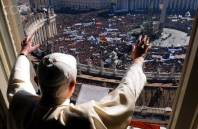 His reluctance to believe what fellow disciples said about Jesus Christ’s resurrection earned him the name Doubting Thomas. Centuries later, St Thomas — believed to be the man who brought Christianity to India — finds himself in the shadow of ‘doubt’ with none other than the Pope contradicting his evangelical trek in the country, only to modify it a few days later. But far from dousing the fire, the Pope has rekindled a debate and given critics an issue on the platter.
His reluctance to believe what fellow disciples said about Jesus Christ’s resurrection earned him the name Doubting Thomas. Centuries later, St Thomas — believed to be the man who brought Christianity to India — finds himself in the shadow of ‘doubt’ with none other than the Pope contradicting his evangelical trek in the country, only to modify it a few days later. But far from dousing the fire, the Pope has rekindled a debate and given critics an issue on the platter.Pope Benedict XVI made the statement at the Vatican on September 27, 2006. Addressing the faithful during the Wednesday catechises, he recalled that St. Thomas first evangelized Syria and Persia, and went on to western India from where Christianity reached Southern India. The import of the statement was that St. Thomas never travelled to south India, but rather evangelized the western front, mostly comprising today’s Pakistan.
Knowingly or unknowingly, he had in one stroke challenged the basis of Christianity in India and demolished long-held views of the Church here that St Thomas landed in Kerala, where he spread the gospel among Hindus. The comments were especially a letdown for the Syrian Christians of Kerala, who proudly trace their ancestry to upper-caste Hindus said to have been evangelized by St Thomas upon his arrival in 52 AD.
The comments went unnoticed until Sathya-Deepam, the official mouthpiece of the Syro-Malabar church, picked it up. Writing in it, George Nedungat, a member of the Oriental Pontifical Institute of Rome, conveyed the community’s anguish and claimed that previous popes had recognised St. Thomas’s work in south India.
 On 27 September 2006, Pope Benedict XVI made a speech in St. Peter’s Square at Vatican City in which he recalled an ancient St. Thomas tradition. He said that “Thomas first evangelized Syria and Persia and then penetrated as far as western India, from where Christianity also reached South India”.[1] This statement upset the Indian bishops in Kerala, and as it was perceived to be a direct violation of the beliefs of many Indian Christians, it was brought to the attention of the Pope’s editors and amended the next day on the Vatican’s website to read that St. Thomas himself had reached South India. G. Ananthakrishnan’s article “Thomas’s visit under doubt” in the Times of India, 26 December 2006, reads:
On 27 September 2006, Pope Benedict XVI made a speech in St. Peter’s Square at Vatican City in which he recalled an ancient St. Thomas tradition. He said that “Thomas first evangelized Syria and Persia and then penetrated as far as western India, from where Christianity also reached South India”.[1] This statement upset the Indian bishops in Kerala, and as it was perceived to be a direct violation of the beliefs of many Indian Christians, it was brought to the attention of the Pope’s editors and amended the next day on the Vatican’s website to read that St. Thomas himself had reached South India. G. Ananthakrishnan’s article “Thomas’s visit under doubt” in the Times of India, 26 December 2006, reads:His reluctance to believe what fellow disciples said about Jesus Christ’s resurrection earned him the name Doubting Thomas. Centuries later, St Thomas — believed to be the man who brought Christianity to India — finds himself in the shadow of ‘doubt’ with none other than the Pope contradicting his evangelical trek in the country, only to modify it a few days later. But far from dousing the fire, the Pope has rekindled a debate and given critics an issue on the platter.
Pope Benedict XVI made the statement at the Vatican on September 27, 2006. Addressing the faithful during the Wednesday catechises, he recalled that St. Thomas first evangelized Syria and Persia, and went on to western India from where Christianity reached Southern India. The import of the statement was that St. Thomas never travelled to south India, but rather evangelized the western front, mostly comprising today’s Pakistan.Knowingly or unknowingly, he had in one stroke challenged the basis of Christianity in India and demolished long-held views of the Church here that St Thomas landed in Kerala, where he spread the gospel among Hindus. The comments were especially a letdown for the Syrian Christians of Kerala, who proudly trace their ancestry to upper-caste Hindus said to have been evangelized by St Thomas upon his arrival in 52 AD.The comments went unnoticed until Sathya-Deepam, the official mouthpiece of the Syro-Malabar church, picked it up. Writing in it, George Nedungat, a member of the Oriental Pontifical Institute of Rome, conveyed the community’s anguish and claimed that previous popes had recognised St. Thomas’s work in south India.
No comments:
Post a Comment